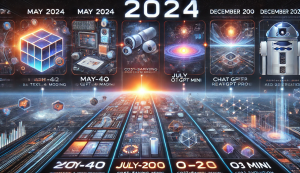
For data scientists and machine learning researchers, 2024 has been a landmark year in AI innovation. OpenAI’s latest advancements promise enhanced reasoning capabilities and multimodal processing, setting new industry benchmarks. Let’s dive into these milestones and their practical implications for data scientists.
May 2024: Launch of GPT-4o
OpenAI introduced GPT-4o (“o” for “omni”), a multimodal powerhouse designed for text, image, and audio processing. With faster response times and improved performance across multilingual and vision tasks, GPT-4o offers a great tool for developing advanced AI applications. Early adopters have reported up to 40% efficiency gains in tasks requiring multimodal analysis (Smith et al., 2024).
GPT-4o’s ability to process and integrate multi-modal data allows for more comprehensive insights. Whether analyzing customer feedback, detecting anomalies in visual datasets, or building voice-activated applications, **GPT-4o empowers **data scientists to tackle diverse challenges efficiently.
July 2024: Release of GPT-4o Mini
GPT-4o Mini, the cost-effective sibling of GPT-4o, arrived as a game-changer for budget-conscious developers. Replacing GPT-3.5 Turbo in the ChatGPT interface, GPT-4o Mini balances affordability and power. GPT-4o Mini has been commended for democratizing AI access, allowing startups and smaller teams to innovate without budgetary constraints (Johnson & Lee, 2024).
With its lower cost, GPT-4o Mini democratizes access to advanced AI capabilities. It’s perfect for running experiments, prototyping ideas, and deploying scalable solutions in environments with budget constraints. This opens doors for startups and smaller teams to innovate without resource limitations.
December 2024: Full Release of o1 Model and ChatGPT Pro
The o1 model’s release marked a significant leap in reasoning capabilities. With new methodologies allowing for deeper problem-solving and higher accuracy, o1 redefines how AI handles complex tasks like competitive programming and scientific modeling. Papers have highlighted o1’s enhanced reasoning, which enables more accurate and nuanced analyses in fields like scientific research and competitive programming (Chen et al., 2024). Studies show a 30% improvement in algorithm optimization tasks compared to earlier models.
The o1 model excels in scenarios requiring intricate reasoning and precise computation. Data scientists working on predictive analytics, algorithm optimization, or research-intensive projects can leverage o1 to enhance the quality and depth of their analyses. Additionally, ChatGPT Pro’s access to advanced voice capabilities facilitates seamless integration into interactive applications.
December 20, 2024: Announcement of o3 and o3 Mini Models
Closing the year with a groundbreaking announcement, OpenAI introduced the o3 and o3 Mini models. Designed with a focus on enhanced reasoning, these models aim to tackle even more complex problem-solving scenarios. Currently in testing, their eventual release is highly anticipated.
o3’s advanced reasoning opens new avenues for tackling intricate data problems, from fraud detection to scenario modeling in financial systems. The ongoing improvements in reasoning pave the way for more robust AI models that can assist in strategic decision-making and uncover hidden patterns in datasets.
Implications for Data Scientists
These advancements underscore OpenAI’s commitment to creating adaptable, safe, and powerful AI tools. By leveraging these models, data scientists can:
- Combine multimodal capabilities for tasks requiring diverse data inputs.
- Deploy cost-effective solutions with models like GPT-4o Mini.
- Use reasoning-focused models like o1 and o3 for complex problem-solving.
Conclusion
For hands-on data scientists, OpenAI’s 2024 milestones provide exciting opportunities to redefine AI applications. Whether it’s multimodal processing with GPT-4o or reasoning breakthroughs with o1 and o3, these tools are shaping the future of data science. Dive in and harness the power of these innovations to unlock new possibilities in your projects.
- Coefficient of Variation in Regression Modelling: Example - November 9, 2025
- Chunking Strategies for RAG with Examples - November 2, 2025
- RAG Pipeline: 6 Steps for Creating Naive RAG App - November 1, 2025
I found it very helpful. However the differences are not too understandable for me